
Using the Hardy-Weinberg equation to calculate allele and genotype frequencies. Created by Sal Khan.
- Subject:
- Biology
- Life Science
- Material Type:
- Lesson
- Provider:
- Khan Academy
- Provider Set:
- Khan Academy
- Author:
- Sal Khan
- Date Added:
- 06/23/2014

Using the Hardy-Weinberg equation to calculate allele and genotype frequencies. Created by Sal Khan.
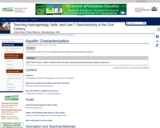
Well Field Practice: aquifer characterization through conducting and interpreting of aquifer pump tests.
(Note: this resource was added to OER Commons as part of a batch upload of over 2,200 records. If you notice an issue with the quality of the metadata, please let us know by using the 'report' button and we will flag it for consideration.)
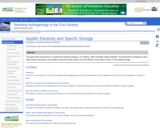
The goal of this experiment is to measure the specific storage Ss of a balloon, which simulates aquifer elasticity. The experiment is designed to give observational meaning to the variable, increment of fluid content, and the influence of the state of stress on the specific storage. Increment of fluid content is the poroelastic variable defined as the amount of water added to storage per unit bulk volume. It is analogous to quantity of heat added to a unit volume of a material. Specific storage can then be expressed rigorously as the ratio of increment of fluid content divided by the change in head with specified external stress or strain conditions on the REV.
(Note: this resource was added to OER Commons as part of a batch upload of over 2,200 records. If you notice an issue with the quality of the metadata, please let us know by using the 'report' button and we will flag it for consideration.)
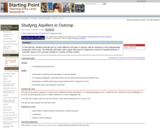
Students describe the hydrogeologic properties of different sedimentary and volcanic rocks.
(Note: this resource was added to OER Commons as part of a batch upload of over 2,200 records. If you notice an issue with the quality of the metadata, please let us know by using the 'report' button and we will flag it for consideration.)

Living Atlas Indicators of the Planet provide the user with up-to-date data, maps, graphs, charts, animation and other visuals to explore the science of climate and environmental change. 18 indicators from Air Quality to Women in Parliament can be explored.
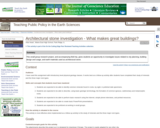
This activity is best placed as a follow-up activity to the study of minerals and the three major rock types in an introductory physical geology course. Students are required to work in small cooperative groups. Each group chooses a major building to research. The group divides the tasks associated with the research and presentation of information. The overall goal of the project is for students to gain an understanding of the importance and uses of earth materials in building and planning major buildings in an urban setting.
The general format of the project is:
1. Students research building design, placement and use of earth materials in a major building.
2. Students research the earth materials used in their building.
3. Students create and show their PowerPoint presentation in class.
4. Students prepare and deliver an on-site oral presentation about their building.
The activity helps students connect a basic study of earth materials to urban planning and living.
(Note: this resource was added to OER Commons as part of a batch upload of over 2,200 records. If you notice an issue with the quality of the metadata, please let us know by using the 'report' button and we will flag it for consideration.)

Student teams investigate Arctic Sea Ice by analyzing actual data and making predictions. A worthwhile extension is to predict the first year that the Arctic Ocean will be ice free.
(Note: this resource was added to OER Commons as part of a batch upload of over 2,200 records. If you notice an issue with the quality of the metadata, please let us know by using the 'report' button and we will flag it for consideration.)

See the many birds that spend their summer in the Arctic in this video segment from Nature.
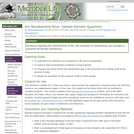
This example Socratic questioning page provides an outline for leading a classroom discussion regarding whether or not nanobacteria exist. Sample questions, resources for background information, and tips and assessment information are provided.

This resource is a video abstract of a research paper created by Research Square on behalf of its authors. It provides a synopsis that's easy to understand, and can be used to introduce the topics it covers to students, researchers, and the general public. The video's transcript is also provided in full, with a portion provided below for preview:
"The TAM subfamily of receptor kinases has been implicated in tumor development and progression. Their roles in efferocytosis, regulation of immune cells, secretion of inflammatory factors, and epithelial-to-mesenchymal transition make them key players in tumor development and progression. But TAM signaling is not always beneficial to tumor growth. In glioblastoma (GBM), the most prevalent and lethal primary brain tumor in adults it appears that TAM receptors may also have anti-tumor effects. While upregulation of TAM signaling is usually associated with GBM development, progression, and poor prognosis, TAM receptors may also activate pathways that trigger anti-tumor immune responses and their immunosuppressive role in the tumor microenvironment may obstruct GBM progression..."
The rest of the transcript, along with a link to the research itself, is available on the resource itself.

Students investigate the intelligence of dinosaurs by comparing the relative size of brain and body mass to living animals. Students plot the living animals to determine a general relationship of brain and body mass and then use that relation to interpret a range of dinosaurs. The activity gives students practice in graphical data comparison and other methods of data analysis. Students also investigate how well this method works and what weaknesses it might have.
(Note: this resource was added to OER Commons as part of a batch upload of over 2,200 records. If you notice an issue with the quality of the metadata, please let us know by using the 'report' button and we will flag it for consideration.)

A lab activity evaluating the hypothesis that Earth's biosphere is currently undergoing a mass extinction, the so-called "sixth extinction." Students practice quantitative skills by calculating extinction percentages and rates in recent history using real-world data from the work of Ceballos et al. (2015). Then, they integrate modern and fossil data to see whether recent extinctions more closely resemble a mass extinction or the background rate of extinction in the fossil record. In the process, students critically examine sources of error and uncertainty and reflect on how to resolve them.

This resource is a video abstract of a research paper created by Research Square on behalf of its authors. It provides a synopsis that's easy to understand, and can be used to introduce the topics it covers to students, researchers, and the general public. The video's transcript is also provided in full, with a portion provided below for preview:
"It’s a feared moment for every scientist: the discovery that years of painstaking research has led to results that can't be repeated. Many think that poorly characterized antibodies have contributed to this reproducibility crisis more than any other laboratory tool. A new study published in Molecular Cell supports this hypothesis, at least in the context of chromatin immunoprecipitation. Although accurate ChIP interpretation depends on near-perfect antibody specificity, the report shows that many of these reagents are far less capable than their advertising suggests, which calls into question several widely accepted paradigms on genomic regulation. The study focused on histone post-translational modifications; specifically all three methylation states of lysine 4 on histone H3. Through ChIP experiments, H3K4 methylation has been strongly linked to transcriptional control..."
The rest of the transcript, along with a link to the research itself, is available on the resource itself.

This resource is a video abstract of a research paper created by Research Square on behalf of its authors. It provides a synopsis that's easy to understand, and can be used to introduce the topics it covers to students, researchers, and the general public. The video's transcript is also provided in full, with a portion provided below for preview:
"Deep-sea hydrothermal vent ecosystems host an array of macrofauna, including many invertebrates. These animals adapt to the extreme conditions by forging endosymbiotic relationships with chemoautotrophic bacteria. Phages, viruses that infect prokaryotes, can fundamentally affect endosymbiotic bacteria, but their specific roles in deep-sea vent endosymbionts are not yet known. A recent study utilized metagenomics, transcriptomics, and proteomics to examine the endosymbiotic phages associated with the deep-sea vent snail Gigantopelta aegis. These phages infected methane- and sulfur-oxidizing bacteria, and there was evidence of both lysogenic and lytic lifecycles. The genomes also showed evidence of an arms race between bacteria and phages, with the bacteria encoding defense systems like CRISPR–Cas to break down phage DNA and the phages encoding their own anti-defense mechanisms. The phages also had horizontally acquired auxiliary metabolic genes, which could benefit replication..."
The rest of the transcript, along with a link to the research itself, is available on the resource itself.

If you’ve been paying attention so far in this series, you’ve probably heard of benzene. This molecule is flat, cyclic, and belongs to a special class of compounds known as aromatics. In this episode of Crash Course Organic Chemistry, we’ll learn all about aromatic compounds, their properties, reactivities, and some of the most important examples, like benzene. We’ll also revisit our friend NMR, and hear about some dubious science history!

This resource is a video abstract of a research paper created by Research Square on behalf of its authors. It provides a synopsis that's easy to understand, and can be used to introduce the topics it covers to students, researchers, and the general public. The video's transcript is also provided in full, with a portion provided below for preview:
"The tick-borne parasite Theileria annulata can cause life-threatening illness in cows. Buparvaquone is the only available drug treatment, but the incidence of buparvaquone (BPQ) resistance is increasing so alternative therapies are needed. To help, researchers recently tested the efficacy of the anti-malaria drug artemisinin and its derivatives against T. annulata infection. Artemisinin itself wasn’t effective, but all of its derivatives were able to selectively kill parasite-infected cells. Artesunate (ARS) and dihydroartemisinin (DHART) were especially potent and either drug could act synergistically with BPQ, enhancing the parasite-killing effects of the individual compounds. Investigation of the mechanism revealed that ARS and DHART caused oxidative stress and DNA damage in the infected cells which activated the protein p53 and the caspase-dependent cell death pathway..."
The rest of the transcript, along with a link to the research itself, is available on the resource itself.

This resource is a video abstract of a research paper created by Research Square on behalf of its authors. It provides a synopsis that's easy to understand, and can be used to introduce the topics it covers to students, researchers, and the general public. The video's transcript is also provided in full, with a portion provided below for preview:
"Colorectal cancer (CRC) is one of the most common gastrointestinal malignancies, and 40% of cases are related to mutation of the oncogene KRAS. However, no KRAS-targeting drugs are currently available for cancer treatment, and patients with KRAS mutations are insensitive to anti-EGFR therapy, which is often used for CRC. To improve treatment options, a new study tested the combined effects of the drugs artesunate and WNT974 on KRAS-mutant CRC. In vitro, the combination synergistically reduced CRC growth and decreased KRAS protein levels and activity, while inducing KRAS degradation via the ubiquitin–proteasome pathway, thereby reducing the oncogene’s influence. Specifically, the induced KRAS degradation was mediated by upregulation of ANAPC2, as well as upregulation of β-TrCP and GSK-3β. In addition, the combination treatment suppressed the PI3K/Akt/mTOR pathway, which is downstream of KRAS and supports tumor growth..."
The rest of the transcript, along with a link to the research itself, is available on the resource itself.
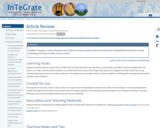
Students are given a choice of sources from which to choose an article relevant to the course (Sustainability Science) for review, including connection to other course content. Integration of article content with other course materials is an important component.
(Note: this resource was added to OER Commons as part of a batch upload of over 2,200 records. If you notice an issue with the quality of the metadata, please let us know by using the 'report' button and we will flag it for consideration.)

How humans have shaped plants and animals through artificial selection and domestication.
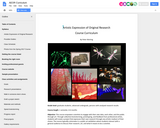
Grade level: graduate students, advanced undergrads, persons with analyzed research results
Course length: 1 semester, 4-6 months
Objective: This course empowers scientists to engage with their own data, each other, and the public through art. Through collective brainstorming, prototyping, and feedback from professional artists, students will create a project that expresses their own research through any artistic medium of their choice. The course typically culminates in a public art exhibition where students interact with a general audience to discuss their research, art, and what it means to be a scientist.